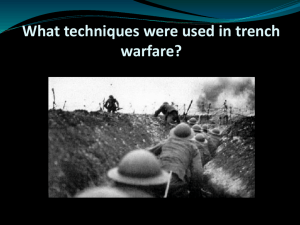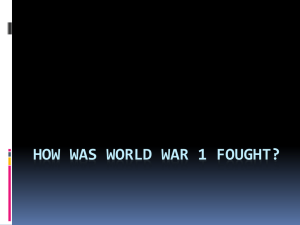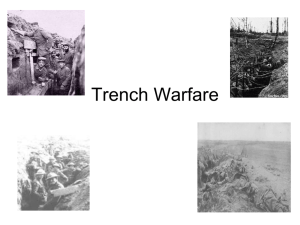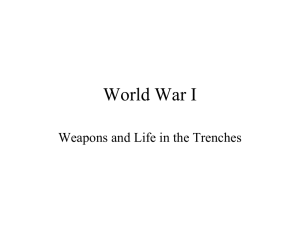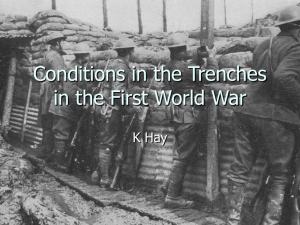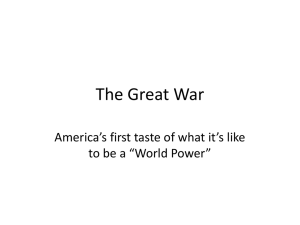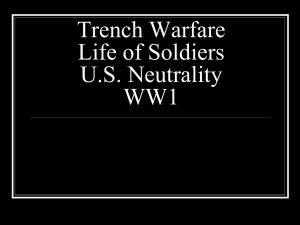Trench warfare
advertisement
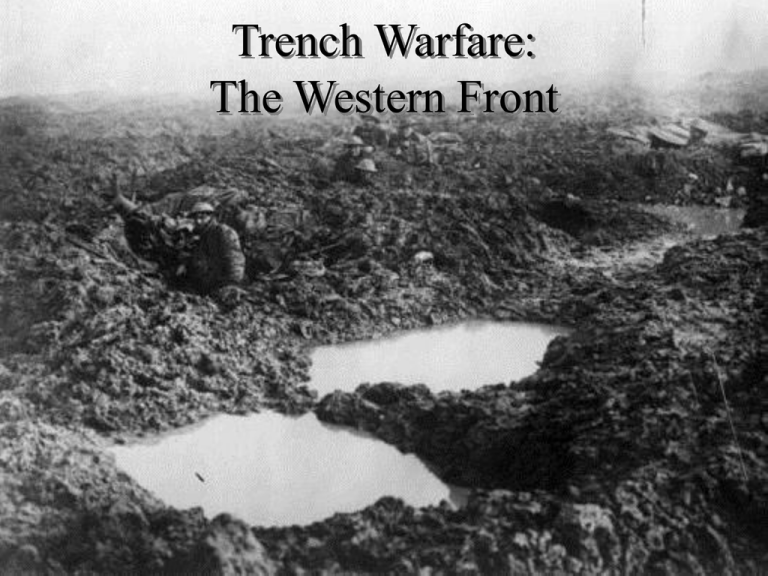
Trench Warfare: The Western Front A New Kind of Warfare • No one saw the stalemate coming – Generals hadn’t planned for it – Poor decision making at first – After huge losses and great costs, Generals changed their techniques of warfare to reflect the new reality Change 1: Trench Warfare • Most obvious new feature of war – Began as simple shelters in late 1914 – By 1915, complex defensive systems Idealized cross-section of a front-line trench. These were supported by much stronger reserve trenches and linked by communication trenches. German trenches were generally stronger and better constructed than Allied trenches. The Germans generally held better ground and had established their trenches in the early stages of war. Many of their dug-outs and machine-gun posts were reinforced with concrete which provided a stronger defense against artillery bombardment. Trench System Cut-Away Activity: Getting the supplies through! X • • • Y Label the following features: – Front-line trench – Support trenches – No man’s land Explain why you think the trenches are arranged as zigzag, not straight, lines If you had to get from your headquarters behind the lines (marked X) to the front-line position (marked Y), how would you get there? Activity: Investigating Visual History • • • • One of the biggest problems facing the army planners was supplying the army with food, weapons and other equipment. Use the above sources to compile a 10-item list of the things the soldiers would need A modern cut-away, an aerial photo, and two pictures of trenches are three different kinds of evidence. Explain how each is useful to an historian. Write your own 5-point definition of trench warfare to prepare for a letter from the trenches. Explain why the two trenches in the photos are so different. Change 2: Artillery Became More Powerful • King of Battle – For weeks at a time it pounded enemy trenches – Example: Battle of the Somme; BEF shelled (G) trenches for 7 days (168 hours), throwing 1.5 million shells at the Kaiser’s soldiers – Caused more casualties than any other weapon • From pretender to king – 1914: Artillery inaccurate, often shelling own trenches, and scarcity of shells – 1916: Artillery much larger, much more accurate, abundant shells – Industries produced millions of shells/month Change 3: Cavalry Became Less Important • The end of the cavalry – All sides thought speed & mobility of cavalry would prove decisive … they were wrong – Too vulnerable to artillery, machine-guns – In one charge, 397 of 400 horses killed – No man’s land too uneven for a charge • Horses found their nitch – Horses & mules were used extensively to transport supplies to the trench systems Change 4: Infantry Became More Important • Backbone of the army – Before war infantry was seen as force that occupied ground after cavalry captured it – Cavalry charge replaced by infantry charge • ‘Over the top’ – A major assault usually followed these steps: Attacker’s artillery bombarded defender’s trenches; called ‘barrage’ This Tommie’s (British soldier) kit weighed about 65 lbs. (F) & (G) soldiers carried heavier gear. Steel helmets were introduced in 1915. Bayonets were fixed to rifles before going ‘over the top’. 1 2 4 3 Attackers either failed or captured frontline trenches. Defenders would counterattack Infantry went ‘over the top’ & raced against defenders setting up machine guns Defenders had advantage. Machine guns swept attacking infantry in crossfire ‘Over the Top’ • Machine guns were devastating – Fired 8 bullets/second – Many machine guns in trenches – One expertly used machine gun could kill 500 attacking soldiers in minutes • Why order soldiers to charge? – At first, only strategy generals had – Theory was that, if enough men charged, some would inevitably get to enemy trenches – Generals worked on other strategies, but for most of the war, this is the one they had • By 1917, new tactics began to emerge – – – – New camouflage Better coordination with artillery & infantry Gas masks Tanks (Allies) German-style barbed wire plan. Germans were considered the most effective users of barbed wire French barbed wire team If you were an attacking soldier how could you get through these barbed wire defenses? How might the following factors affect your answer? -It is completely dark -You are being fired on -You are carrying heavy equipment -You are wearing a gas mask Over the Top, a painting by John Nash. It is based on an attack that he took part in, in 1917, near Cambrai. The soldiers had to climb out of their own trench, charge towards the German trench and try to capture it. Of 80 men in his company, 68 were killed in the first five minutes of the attack. Look at the painting. One of the artist’s aims was to show how vulnerable soldiers were when going over the top. Do you think he succeeded? Explain your answer. Day-to-Day Tasks • A normal day was actually boring – Major attacks occurred once or twice a year • 99% boredom & 1% terror … routines: – – – – – Digging & repairing trenches Carting supplies up communication trenches Sentry duty looking through periscopes Manning listening posts Simply manning the trenches • Sappers – Ex-miners who built tunnels underneath enemy trenches to blow them up • Raiding parties – Raids into enemy trenches to capture prisoners & gather intelligence Change 5: Poison Gas Change 5: Poison Gas • April 1915: (G) first use gas – Chlorine gas panicked (GB) troops – 7 mile whole in British lines – (G) never expected such success, so wasn’t prepared to advance through British trenches • Perfecting the vile mist – More deadly gases (mustard gas) developed – Purpose changed from disabling to killing • Gas masks developed – Very effective if put on in time – Only 3,000 British troops actually died from gas, yet it was the most feared weapon Gassed, a painting by John Singer Sargent. A famous portrait painter, Sargent was commissioned in 1918 to paint a memorial picture of the soldiers killed and injured in the war. Do you think Wilfred Owen would have approved of this painting as a memorial? Explain your answer. British soldiers blinded by gas Change 6: Tanks • Brits almost blow it – Britain’s army initially rejected idea – Winston Churchill paid for development w navy $$$ • Tanks first used at Somme – Crushed barbed wire, shot up Germans, raise British moral and … broke down – First machines were mechanically unreliable • Nov. 1917: Cambrai – Tanks trashed (G) lines – Got ahead of infantry and were destroyed • 1918: (G) responds – Armor-piecing machine gun bullets – Artillery turned into anti-tank guns – Flamethrowers (ouch!) Focus Task: How did fighting on the Western front change? • You have studied how the equipment and the tactics used on the Western Front were adapted to the realities of trench warfare. • Work in pairs. You each have to compile advice to be included in a ‘soldier’s Guide’. You should include advice on tactics and equipment. One of you will write the advice as it might be given in 1914 at the outbreak of the war. The other will write your advice as if it was 1918, at the end of the war. Compare your ideas with your partner’s ideas. • Afterward, write three paragraphs to explain the changes in fighting during the war. You can use this structure: – Para 1: how the war was different from what people expected. – Para 2: ways in which techniques and equipment were adapted to trench warfare. – Para 3: what things did not change and why. The End Assignment: Letter from the Trenches PSDs on A New Kind of Warfare • • The spirit of the bayonet … must be inculcated in all ranks so that they may go forward with that aggressive determination and confidence of superiority born of continual practice … In an assault the enemy must be killed with the bayonet. Firing should be avoided for in the mix-up, a bullet, passing through an opponent’s body, may kill a friend who happens to be in the line of fire. – From a British gov’t pamphlet on military training, published before the war. We see the attackers coming. Our machine guns rattle, rifles crack. We recognize the helmets of the attackers. They are French. They have already suffered heavily when they reach our barbed wire. We retreat. We leave bombs behind us in the trench. We hurl explosives at the feet of the enemy before we run. At last we reach one of our support trenches that is in somewhat better condition. It is manned and ready for the counter-attack. It does not come quiet to hand-to-hand fighting; they are driven back. We arrive once again at our original shattered trench and pass on beyond it … Now we are so close on the heels of our retreating enemies that we reach their line almost at the same time as they do … But we cannot stay here long. We must retire under cover of our artillery to our own position … We get back pretty well. There is no further attack by the enemy. – Adapted from All Quiet on the Western Front, a novel by Erich Maria Remarque. He was a German who fought on the Western Front, and was twice badly wounded. – How closely does the above PSD match the typical infantry attack? – Why was it so easy for the Germans to recapture the trench? PSDs on A New Kind of Warfare • • • • • • • • • • • • • • • • • • • • • Gas! Gas! Quick, boys! – An ecstasy of fumbling. Fitting the clumsy helmets just in time; But someone still was yelling out and stumbling And flound’ring like a man in fire or lime … Dim, through the misty panes and thick green light, As under a green sea, I saw him drowning. In all my dreams, before my helpless sight, He lunges at me, guttering, choking, drowning. If in some smothering dreams you too could pace Behind the wagon that we flung him in, And watch the white eyes writhing in his face, His hanging face, like a devil’s sick of sin; If you could hear, at every jolt, the blood Come gurgling from the froth-corrupted lungs, Obscene as cancer, bitter as the cud Of vile, incurable sores on innocent tongues, My friend, you would not tell with such high zest To children ardent for some desperate glory, The old lie: Dulce et decorum est Pro patria mori. [How sweet and proper it is to die for your country] From a poem by Wilfred Owen. Owen served on the Western Front through most of the war. He became the most celebrated of the poets of the First World War. He was killed just days before the final armistice in November 1918. According to the poem what were the effects of poison gas on the victim? Why do you think gas attacks were regarded with such fear?
